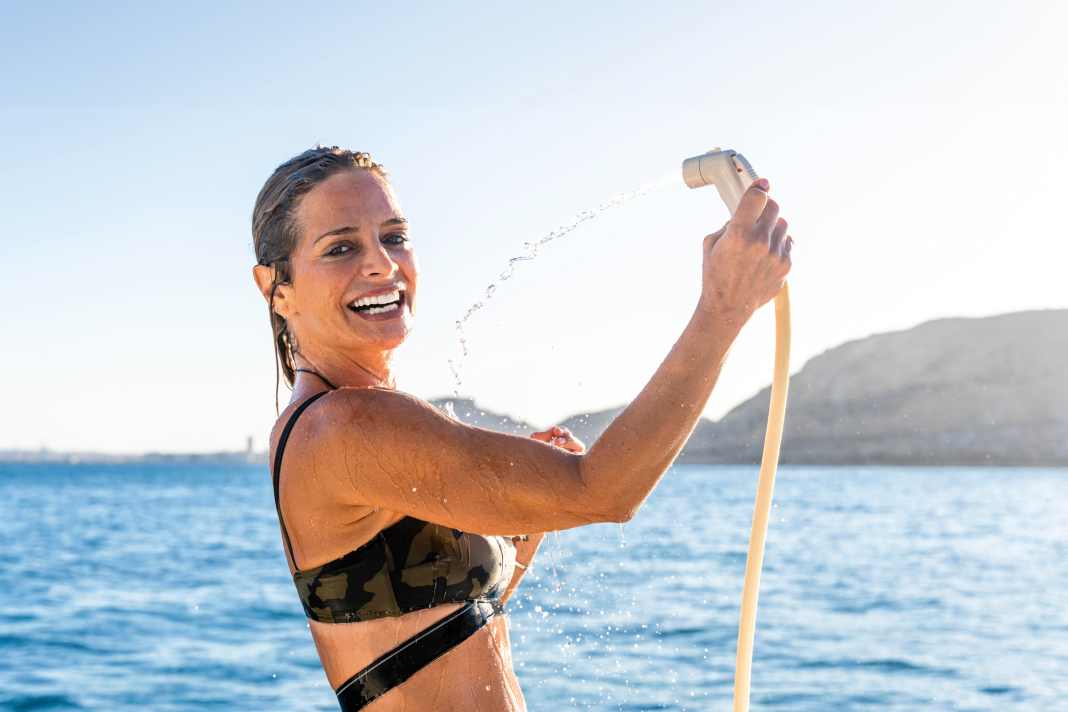



Hot water boilers are often already part of the standard equipment on larger motorboats or can be ordered as an optional extra. But are they really just a convenient convenience for large yachts, or are they also worth buying for a smaller day cruiser?
Our market overview shows the appliances currently available on the market with a volume of up to 80 litres. However, we do not claim to be exhaustive.
Basics for showering on board with a hot water boiler
However, in order to get a feel for the sizes of the boilers presented, the basics should first be explained. At first glance, the volume of some manufacturers' boilers may seem very small. The average consumption for a shower at home is between 50 and 150 litres. A normal shower head consumes around 12 to 15 litres per minute, while economical models manage to halve this figure. In the marine sector, the shower heads are also generally much smaller and therefore consume significantly less as the flow rate is lower. Moreover, very few skippers will take an extensive shower on board, as they are used to doing at home. As the specified average value refers to a hot/cold water mixture, it can be assumed that an average of 20 to 40 litres of hot water is required per shower. Unless, of course, you are a real hot shower enthusiast.
The warm shower package from Tigerexped
The Tigerexped company offers the Warm Shower Package, which has the same name but comes from the off-road sector. A complete package that is operated with an air heater, which also heats the water in the boiler. This option is ideal for cooler boating areas where the outside temperature calls for a closed tarpaulin or for longer stays in a bay. This is because if it is cooler or cold outside, the auxiliary heater usually runs continuously inside anyway. The air emitted by the parking heater is then carried through the boiler and heats the water in the tank before the warm air heats the rest of the boat.
If the cruise is planned so that the boat will be travelling more often or for longer distances, there is the option of using a further hot water preparation variant. In this case, the service water is connected to the engine circuit via an integrated heating coil and heated in this way. However, this requires the engine to have been running for a certain amount of time beforehand so that the water is still warm later in the bay or harbour.
As a third alternative, heating is also possible electrically. This form of heating makes sense if there is sufficient battery capacity or the boat is connected to shore power. Depending on the manufacturer, 12 V, 24 V or 230 V options are available.
Variations with all three heating options are also available and are the best way to have access to hot water in any situation on longer trips.
Offer from the Pundmann company
In addition to the boilers already listed for use with air heaters, Pundmann also offers low-pressure boilers, boilers for water heaters and a mobile version called Boiler in a Box. The Boiler-in-a-Box exception is characterised by the fact that no water system needs to be present in the boat. In addition to a 20-litre hot water tank, the mobile device also has a further 6-litre cold water tank. With an empty weight of just under 11 kg, this is a good alternative for sporadic use, even on smaller boats that would otherwise not be able to accommodate a shower due to lack of space.
Vetus uses double-walled system
If you prefer rapid heating, you should take a closer look at the Vetus boiler. Unlike other boilers, this one does not use a heating coil but a double-walled system. The surface area that is heated is therefore significantly larger than that of other competitors.
Due to the large number of different variations offered by the respective manufacturers, we present in our overview of hot water boilers only some of the models available on the market. Other boilers, which are available but not listed, are available from well-known manufacturers such as Truma, Phaesun Solar and Webasto. However, as these models are powered by gas or purely electrically, they are probably more suitable for long-term use in the camping sector.
Structure of the hot water boiler
The technical design of the boilers is often relatively similar. The boilers are almost always made of stainless steel, while the outer skin or insulation is often made of plastic. Depending on the thickness of the insulation, hot water is still available several hours after the boiler has last been used.
Only the shape of the boilers often differs greatly - from round, which tends to take up a lot of storage space, to square and rectangular, everything is available. The volume also varies greatly, with small models offering litres in the single-digit range, while others with almost 100 litres are more suitable for larger families.

